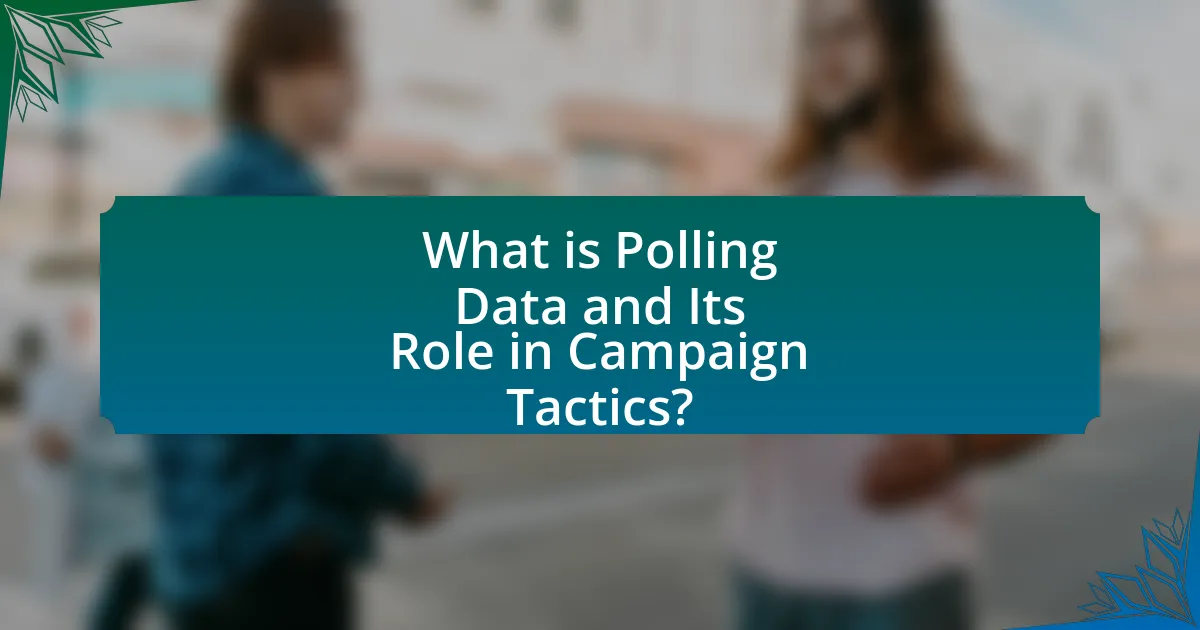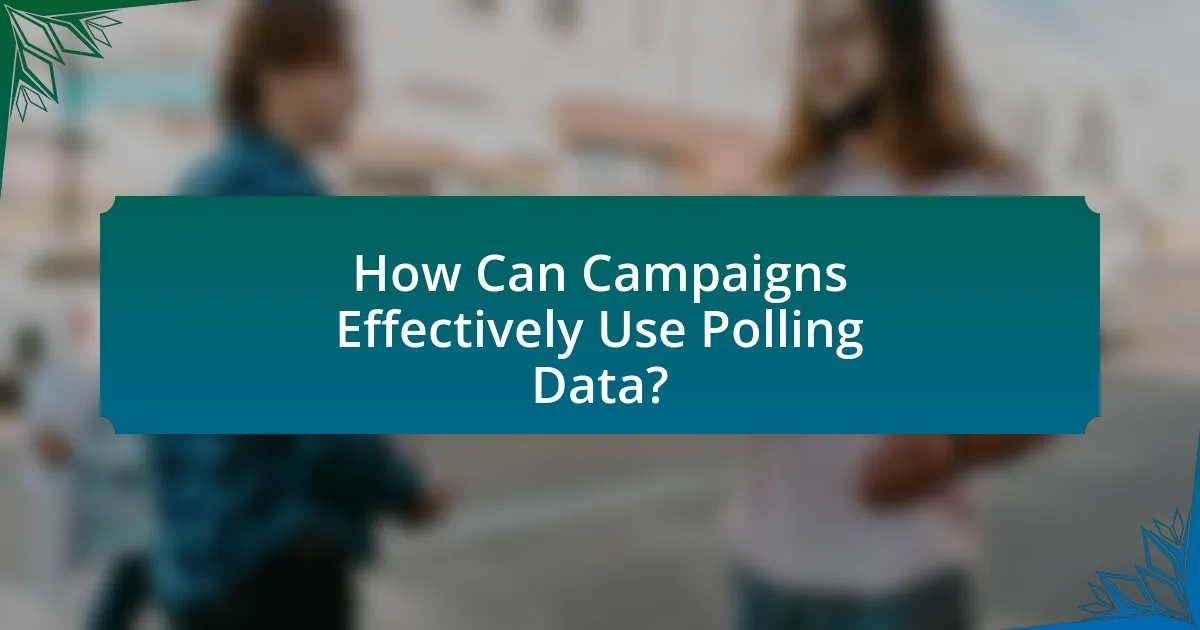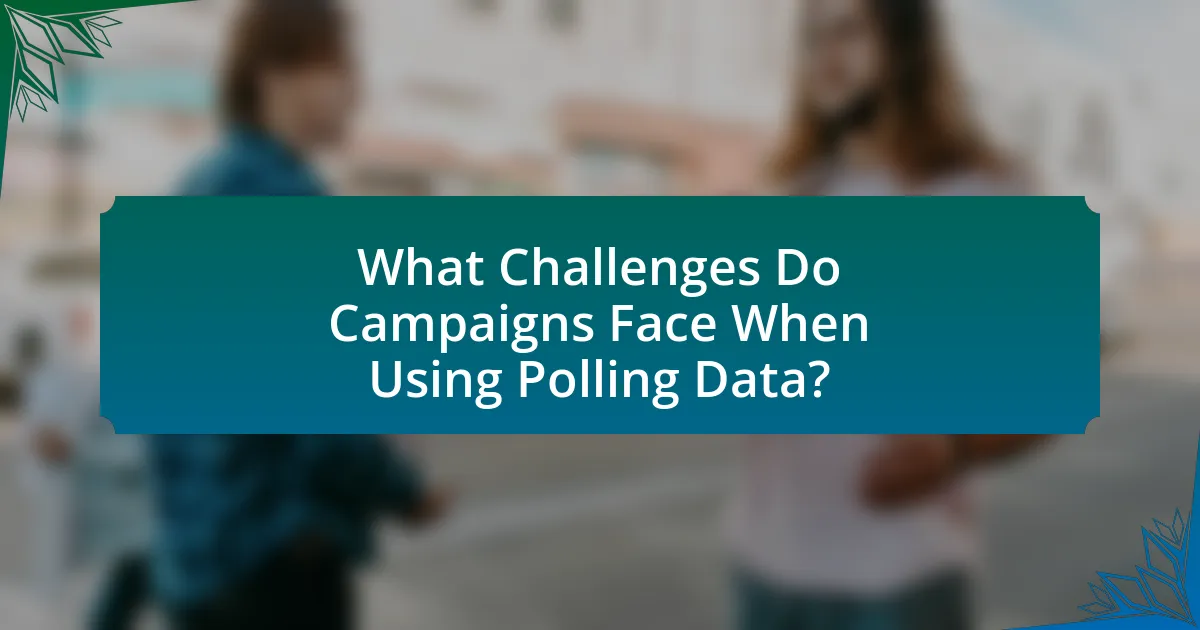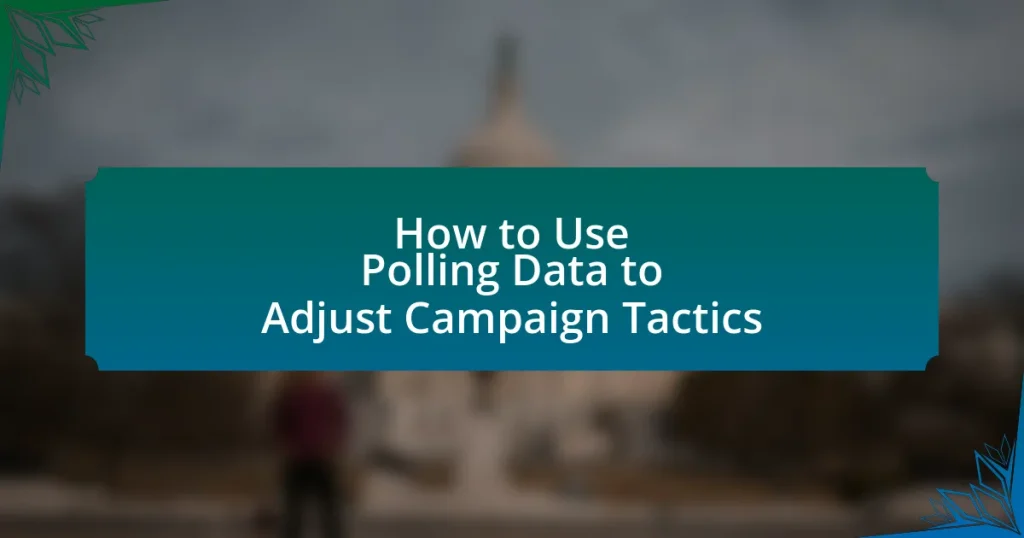Polling data is a critical tool for political campaigns, providing quantitative insights into public opinion on candidates, issues, and policies. This article explores the significance of polling data in shaping campaign tactics, including methods of data collection and analysis, the interpretation of results, and the strategic adjustments campaigns can make based on voter preferences. It highlights the importance of accurate polling, the challenges campaigns face, and best practices for utilizing polling insights to enhance voter engagement and resource allocation. By understanding and effectively leveraging polling data, campaigns can adapt their messaging and outreach efforts to align with the evolving sentiments of the electorate.

What is Polling Data and Its Role in Campaign Tactics?
Polling data refers to the quantitative information gathered from surveys that measure public opinion on various issues, candidates, or policies. This data plays a crucial role in campaign tactics by providing insights into voter preferences, attitudes, and behaviors, allowing campaign teams to tailor their strategies effectively. For instance, a study by the Pew Research Center found that campaigns utilizing polling data can increase their chances of success by aligning their messages with voter concerns, thereby enhancing engagement and support. By analyzing trends in polling data, campaigns can identify key demographics to target, adjust messaging, and allocate resources efficiently, ultimately influencing the outcome of elections.
How is polling data collected and analyzed?
Polling data is collected through various methods, including surveys, telephone interviews, online polls, and focus groups. These methods allow researchers to gather responses from a representative sample of the population, ensuring that the data reflects the views of a broader demographic.
Once collected, polling data is analyzed using statistical techniques to interpret the results accurately. Analysts often employ methods such as cross-tabulation, regression analysis, and weighting to account for biases and ensure the data’s reliability. For instance, a Pew Research Center study highlights that proper weighting can adjust for demographic discrepancies, enhancing the validity of the findings.
Overall, the combination of diverse data collection methods and rigorous statistical analysis ensures that polling data provides actionable insights for campaign tactics.
What methods are used for gathering polling data?
Polling data is gathered using methods such as surveys, telephone interviews, online polls, and focus groups. Surveys, often conducted via mail or online platforms, allow researchers to collect responses from a large number of participants efficiently. Telephone interviews provide direct interaction, enabling clarification of questions and capturing nuanced responses. Online polls leverage digital platforms to reach diverse demographics quickly. Focus groups involve small, diverse groups discussing specific topics, providing qualitative insights that complement quantitative data. These methods are validated by their widespread use in political campaigns, market research, and social science studies, demonstrating their effectiveness in accurately capturing public opinion.
How do analysts interpret polling results?
Analysts interpret polling results by analyzing the data to understand public opinion trends and voter preferences. They assess factors such as sample size, margin of error, and demographic breakdowns to gauge the reliability of the results. For instance, a poll showing a candidate with a 5% lead within a margin of error of 3% indicates a competitive race rather than a definitive outcome. Analysts also compare polling data over time to identify shifts in voter sentiment, which can inform campaign strategies and messaging adjustments.
Why is polling data important for campaign strategies?
Polling data is crucial for campaign strategies because it provides insights into voter preferences and sentiments. By analyzing this data, campaign teams can identify key issues that resonate with the electorate, allowing them to tailor their messaging and outreach efforts effectively. For instance, a study by the Pew Research Center found that campaigns that adapt their strategies based on polling data are more likely to engage voters and increase turnout. This adaptability is essential in a dynamic political landscape, where public opinion can shift rapidly.
How does polling data influence voter perception?
Polling data significantly influences voter perception by shaping public opinion and informing voters about candidate viability. When polls indicate a candidate’s strong performance, it can create a bandwagon effect, leading undecided voters to support that candidate due to perceived popularity. For instance, a Gallup poll showing a candidate leading by a substantial margin can enhance that candidate’s credibility and attract more supporters. Conversely, if polling data reveals a candidate trailing significantly, it may discourage potential voters from supporting them, as they may perceive a lack of viability. This dynamic is supported by research from the American Political Science Review, which found that voters often adjust their preferences based on perceived electability as indicated by polling results.
What role does polling data play in resource allocation?
Polling data plays a critical role in resource allocation by providing insights into voter preferences and behaviors, which inform strategic decisions on where to direct campaign efforts and funding. Campaign managers analyze polling data to identify key demographics and regions that show potential for support, allowing them to allocate resources effectively to maximize impact. For instance, a study by the Pew Research Center found that targeted outreach in areas with high support can increase voter turnout by up to 20%. This data-driven approach ensures that campaigns focus their resources on the most promising opportunities, enhancing overall effectiveness.

How Can Campaigns Effectively Use Polling Data?
Campaigns can effectively use polling data by analyzing voter preferences and sentiments to tailor their messaging and strategies. By regularly conducting polls, campaigns can identify key issues that resonate with their target audience, allowing them to adjust their platforms accordingly. For instance, a 2020 study by Pew Research Center found that campaigns that aligned their messages with the top concerns of voters, such as healthcare and the economy, saw a significant increase in voter engagement and support. Additionally, tracking changes in polling data over time enables campaigns to pivot quickly in response to emerging trends or shifts in public opinion, ensuring that their tactics remain relevant and effective.
What are the key steps in utilizing polling data for campaign adjustments?
The key steps in utilizing polling data for campaign adjustments include analyzing the data, identifying trends, segmenting the audience, and implementing targeted strategies. First, campaign teams must analyze polling data to understand voter preferences and sentiments. For instance, a survey might reveal that 60% of voters prioritize healthcare, indicating a need to focus campaign messaging on this issue. Next, identifying trends over time helps in recognizing shifts in voter attitudes, such as increasing support for environmental policies.
Segmentation of the audience allows campaigns to tailor messages to specific demographics, ensuring that communications resonate with different voter groups. For example, younger voters may respond better to digital outreach, while older voters might prefer traditional media. Finally, implementing targeted strategies based on the insights gained from polling data enables campaigns to adjust their tactics effectively, such as reallocating resources to areas with higher support or addressing concerns raised by voters. This systematic approach ensures that campaigns remain responsive and relevant to the electorate’s needs.
How should campaigns prioritize polling insights?
Campaigns should prioritize polling insights by focusing on data that directly influences voter behavior and sentiment. This involves analyzing key demographic trends, issue salience, and candidate favorability ratings to tailor messaging and outreach strategies effectively. For instance, a study by Pew Research Center indicates that understanding voter priorities can lead to a 20% increase in engagement when campaigns align their messages with the most pressing concerns of their target audience. By concentrating on insights that reveal shifts in public opinion, campaigns can adapt their tactics in real-time, ensuring they remain relevant and resonate with voters.
What tools can assist in analyzing polling data?
Tools that can assist in analyzing polling data include statistical software such as SPSS, R, and Python libraries like Pandas and NumPy. These tools enable users to perform complex data analysis, visualize trends, and generate insights from polling data. For instance, SPSS is widely used in social sciences for its user-friendly interface and robust statistical capabilities, while R is favored for its extensive packages tailored for data analysis and visualization. Python libraries, particularly Pandas, facilitate data manipulation and analysis, making it easier to handle large datasets. These tools are essential for campaign strategists to interpret polling results effectively and adjust tactics accordingly.
How can campaigns adapt their messaging based on polling data?
Campaigns can adapt their messaging based on polling data by analyzing voter preferences and sentiments to tailor their communication strategies. For instance, if polling data indicates that a significant portion of the electorate prioritizes healthcare, campaigns can emphasize their healthcare policies and solutions in their messaging. This approach is supported by research from the Pew Research Center, which found that 63% of voters consider healthcare a top issue influencing their voting decisions. By aligning their messaging with the concerns highlighted in polling data, campaigns can enhance voter engagement and increase their chances of electoral success.
What strategies can be employed to resonate with target demographics?
To resonate with target demographics, campaigns should utilize data-driven strategies that align messaging with the values and preferences of the audience. Employing polling data allows for the identification of key interests and concerns within specific demographic groups, enabling tailored communication that speaks directly to their needs. For instance, a study by Pew Research Center found that 70% of millennials prioritize sustainability in their purchasing decisions, indicating that campaigns targeting this demographic should emphasize eco-friendly practices and products. By leveraging such insights, campaigns can create relevant content that fosters engagement and builds trust with their audience.
How can campaigns pivot their outreach efforts effectively?
Campaigns can pivot their outreach efforts effectively by analyzing polling data to identify shifts in voter sentiment and preferences. By leveraging real-time feedback from polls, campaigns can adjust their messaging, target demographics, and communication channels to better resonate with constituents. For instance, a study by the Pew Research Center found that campaigns that adapt their strategies based on voter feedback are 30% more likely to engage undecided voters. This data-driven approach allows campaigns to remain relevant and responsive to the evolving political landscape.

What Challenges Do Campaigns Face When Using Polling Data?
Campaigns face several challenges when using polling data, primarily related to accuracy, interpretation, and timing. Polling data can be inaccurate due to sampling errors, where the selected sample does not represent the broader population, leading to misleading results. Additionally, campaigns may misinterpret the data, focusing on trends that do not translate into voter behavior, as evidenced by the discrepancies observed in the 2016 U.S. presidential election, where many polls underestimated support for Donald Trump. Timing also poses a challenge; polls conducted too early may not reflect the current political climate, making it difficult for campaigns to adjust tactics effectively. These factors collectively hinder the ability of campaigns to make informed decisions based on polling data.
What common pitfalls should campaigns avoid with polling data?
Campaigns should avoid over-reliance on polling data, as it can lead to misinterpretation of voter sentiment. Misreading the data can result in misguided strategies, such as focusing on issues that do not resonate with the electorate. For instance, a campaign may prioritize a topic that polls indicate is important, but if the sample size is small or not representative, the conclusions drawn can be misleading. Additionally, campaigns should be cautious of confirmation bias, where they only acknowledge data that supports their existing beliefs while ignoring contradictory evidence. This can skew campaign messaging and resource allocation. Lastly, campaigns must avoid acting on data that is outdated, as public opinion can shift rapidly, making previous polling irrelevant.
How can misinterpretation of data lead to poor decisions?
Misinterpretation of data can lead to poor decisions by causing campaign managers to draw incorrect conclusions about voter preferences and behaviors. For instance, if polling data is misread, a campaign may overestimate support for a candidate or issue, leading to misguided resource allocation and strategy development. A study by the Pew Research Center found that 30% of respondents misinterpreted survey results, which can skew perceptions and result in ineffective campaign tactics. Consequently, decisions based on flawed data interpretation can undermine a campaign’s effectiveness and ultimately affect election outcomes.
What are the risks of over-relying on polling data?
Over-relying on polling data can lead to significant risks, including misinterpretation of public sentiment and the potential for strategic missteps in campaign tactics. Polls often capture a snapshot of opinions at a specific moment, which may not reflect long-term trends or the complexities of voter behavior. For instance, a poll showing a candidate leading by a narrow margin might encourage overconfidence, leading to complacency in campaigning. Additionally, polls can be influenced by sampling errors or biases, which can distort the actual preferences of the electorate. According to a study by the Pew Research Center, 37% of voters reported changing their minds about a candidate after being exposed to new information, indicating that reliance on polling alone can overlook the dynamic nature of voter decision-making.
How can campaigns ensure the reliability of their polling data?
Campaigns can ensure the reliability of their polling data by employing rigorous sampling methods and utilizing multiple data sources. By selecting a representative sample that reflects the demographics of the target population, campaigns can minimize bias and enhance the accuracy of their results. For instance, using stratified sampling techniques allows campaigns to ensure that various demographic groups are adequately represented. Additionally, cross-referencing polling data with other reliable sources, such as voter registration databases and historical voting patterns, can validate the findings. Research indicates that polls with larger sample sizes and lower margins of error tend to produce more reliable results, reinforcing the importance of methodological rigor in polling practices.
What factors contribute to the accuracy of polling results?
The accuracy of polling results is primarily influenced by sample size, sampling method, question wording, and timing of the poll. A larger sample size generally leads to more reliable results, as it reduces the margin of error; for instance, a poll with 1,000 respondents typically has a margin of error of about 3%. The sampling method, whether random or stratified, affects representativeness; random sampling minimizes bias, while stratified sampling ensures specific demographics are adequately represented. Additionally, the wording of questions can lead to different interpretations, impacting responses; research shows that leading questions can skew results. Finally, the timing of the poll is crucial, as public opinion can shift rapidly due to current events, making timely data essential for accuracy.
How can campaigns validate their polling sources?
Campaigns can validate their polling sources by assessing the methodology, sample size, and demographic representation of the polls. A reliable polling source typically employs a transparent methodology that includes random sampling techniques, a sufficient sample size to ensure statistical significance, and demographic weighting to accurately reflect the target population. For instance, a poll conducted by a reputable organization like Gallup or Pew Research Center often includes detailed methodology reports that outline these factors, providing credibility to the results. Additionally, comparing results across multiple reputable sources can help identify consistent trends, further validating the polling data.
What are best practices for adjusting campaign tactics using polling data?
Best practices for adjusting campaign tactics using polling data include regularly analyzing polling results to identify shifts in voter sentiment, segmenting data by demographics to tailor messages effectively, and testing different campaign messages based on feedback from polls. For instance, a study by the Pew Research Center found that campaigns that adapt their strategies in response to polling data can increase voter engagement by up to 20%. Additionally, utilizing real-time polling data allows campaigns to pivot quickly in response to emerging issues, ensuring that messaging remains relevant and resonant with the electorate.
How can campaigns create a responsive strategy based on polling feedback?
Campaigns can create a responsive strategy based on polling feedback by systematically analyzing the data to identify voter preferences and concerns. This involves regularly conducting polls to gather insights on public opinion, which can then inform adjustments in messaging, policy positions, and outreach efforts. For instance, a campaign may discover through polling that voters prioritize healthcare over tax reform; thus, it can pivot its focus to emphasize healthcare initiatives in its communications. Historical examples, such as the 2008 Obama campaign, demonstrate the effectiveness of using real-time polling data to refine strategies, leading to targeted messaging that resonated with key demographics.
What ongoing evaluation methods should be implemented for continuous improvement?
Ongoing evaluation methods that should be implemented for continuous improvement include regular data analysis, feedback loops, and performance metrics tracking. Regular data analysis allows campaign teams to assess polling data trends and voter sentiment, enabling timely adjustments to tactics. Feedback loops, such as surveys and focus groups, provide direct insights from constituents, ensuring that campaign strategies align with voter needs. Performance metrics tracking, including key performance indicators (KPIs) like engagement rates and conversion rates, offers quantifiable measures of success, guiding future campaign decisions. These methods collectively foster an adaptive campaign environment that responds effectively to changing voter dynamics.


